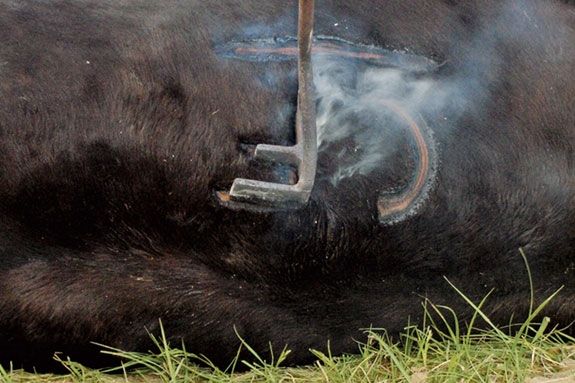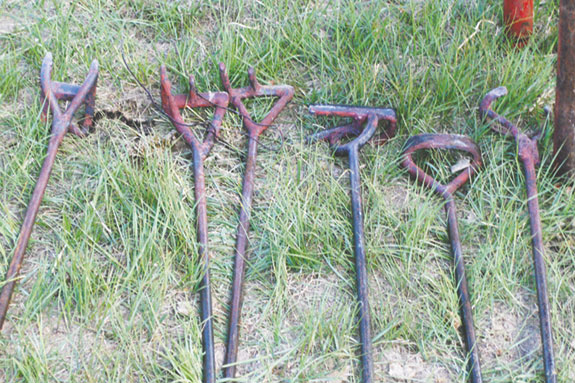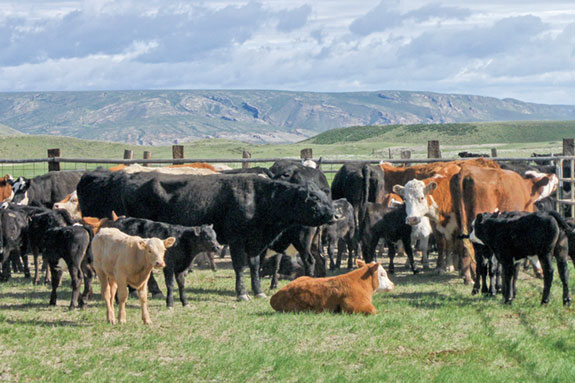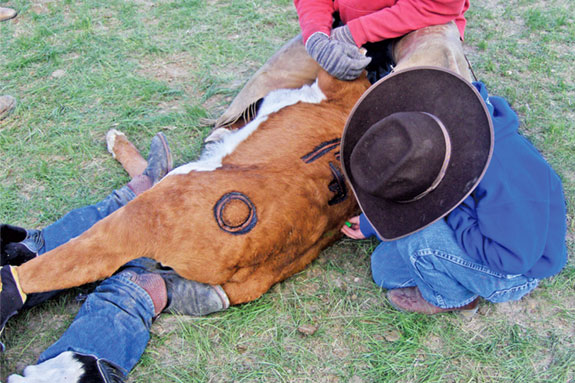The third and fourth generations carry on this proud tradition on the family ranch, located a few miles northwest of Iron Mountain, Wyoming. Charlie and Carol Farthing are the current foundation of the family business.
The Farthing family’s story begins with a pair of brothers. Originally from Buffalo, New York, Harry Farthing had settled southeast of where the ranch lies today. He told his younger brother, Charles, about the good land in Wyoming, which led Charles to come visit his brother in 1902. As Charles rode his horse around the area, looking for ranches that were for sale, a train carrying cattle owned by one of Harry’s neighbors was snaking by. Charles caught up with the train and spoke with the cattle owner, a man named Edwards, who was getting out of ranching. Charles made a deal with Edwards on the moving train, sealed with a handshake, and purchased the land for $3 an acre, with $1.50 down. The deal was made with Charles atop his horse the entire time.
The land purchased was three sections, two sections deeded and one section was leased for a school. Charles and his wife, Maude, already had one son, Tom, and another, Merrill, was born right before the family moved to the ranch in 1903.

“Maude was a character,” Carol said. “She baked the best apple pie.” Carol tells that Maude thought that the land was so desolate, especially one old, ramshackle barn on the property.
“Maude hated that barn, and asked the men to tear it down,” Carol said. When the barn didn’t get torn down, Maude took matters into her own hands. She would go out each day with a crow bar and pry off one piece of that barn, until finally one day, it fell down on its own.
The family brought five Shetland ponies with them – four mares and one stud. Two more daughters, Helen and Betty, were added to the family. Then, the Great Depression hit the family’s finances with a vengeance.
“Everything was mortgaged,” Carol said. “The bank couldn’t get their money out of it. That was the only reason they got to stay.”
The ponies, the only asset with value on the place, became the family’s saving grace and claim to fame over the years. The Farthings became the largest Shetland pony breeder in the U.S., even shipping ponies overseas. During World War II, Farthing Shetland ponies were raffled off to help with the war effort. Today, the family still has 35 Shetland mares and four studs.

“We’ll always have some,” Carol said. “They saved the ranch; they’re where we came from.” The ponies are brought in each December. Since the ponies are only brought in once a year, the foals have never seen people. The University of Wyoming mascot, Cowboy Joe, has a Shetland pony as part of his role. The Farthings have donated four of their ponies to this position since 1950.
The family also began raising Hereford-cross cattle. Crossing Hereford cows with Shorthorn bulls, they were frontrunners of the crossbreeding movement. The family also kept a small sheep flock.
Harry left his ranch to Tom and Merrill. Tom settled there, while Merrill took over Charles’ ranch. Merrill married Grayce, and they had three children: Elizabeth, Merrilyn and Charlie. Elizabeth and Merrilyn claim one of the oldest brands in Wyoming. Charlie has his own brand, as do each of his sons: Chris, Tom and Ryan.
Charlie and Carol met while playing polo, and wed in 1978. Carol has a degree in music from the University of Wyoming, and taught music in Cheyenne for two years before staying on the ranch full-time. Charlie and Carol have the easy, lighthearted banter that comes from years of mutual affection, hard work, and ups and downs of marriage.
Their children have thrived growing up on the ranch. Chris works for Thayler Ranch in LaGrange, Wyoming. Tom and his wife, Sara, work on the ranch and are expecting the first child of the fifth generation of Farthings. Ryan and his wife, Rita, married in September 2009, and also live and work on the ranch.
“I liked growing up on a ranch,” Ryan said. “You were different from your pals in town. It wasn’t bad. I’m glad to be different. You learn to appreciate what you’ve got. It was a great way to grow up.”
“The boys learned a strong work ethic growing up here,” Carol said. The kids started working on the ranch when they reached sixth grade, and each bought their own vehicles and paid for their own schooling by what they saved.
“They’ve had nothing given to them,” Carol said. “They’ve earned it all.”
Over the years, the Farthings have acquired bits and pieces of land to add to the original three sections, totaling just over 50,000 acres.

Today, Charlie and Carol run the ranch, and a herd of commercial crossbred cattle. Over the years, they have gone to breeding mostly Angus cattle. Their 800 cows have been crossbred with Limousin and Charolais, but currently have about 50 Angus bulls and one Hereford bull. The cows are pasture-bred and they do not use artificial insemination. Each year, half of the yearling heifers are kept as replacements. All of the cattle graze year-round on open range. The Farthings wait until a heifer reaches age 3 for her first calving.
“It lets us keep the cows longer,” Carol said. “It’s easier on the heifer and on the calf. To have a 2-year-old heifer calve is like having a teenager have a kid.” Three-year-old heifers also have an easier time calving, which helps the Farthings since they don’t have enough people to assist with calving. Calving starts about April 1, and continues for about 60 days.
“Some go a little long,” Carol said with a smile. “Some cows don’t follow the calendar.” The Farthings prefer that their cows calve outdoors, as they have found it to be healthier for the calves, but do have the facilities to calve 150 cows indoors if they have to.
The whole cow herd runs together, and all cattle work is done on horseback. Most of the ranch land is too rugged to allow four-wheelers.
“We do have snowmobiles, though,” laughs Carol. Working cattle on horseback has proved to be a major advantage for the Farthings. “The cows are gentle, and they handle quietly.” The calves are branded three times a year, and weaned in November. The Farthings spread out working the calves in smaller bunches, which allows them to better monitor the calves’ health.
The calves are vaccinated three times with a BVD modified live vaccine before entering the herd. At branding time, a pasturella-modified live virus vaccine is given, in addition to a brucellosis vaccine. Yearling steers are vaccinated for foot rot.
When steers reach about 22 months, they are sent to a feedlot in Windsor, Colorado, for finishing.
For feed, the family puts up loose hay that is frequently fed in winter.They have found that bales are more difficult to feed, so prefer to stack the hay loosely in huge haystacks.

“The loose hay is more intensive to put up, but it makes better bedding and keeps better,” Ryan said. The stacks stay green and maintain its nutrient value.
The family raises their own horses, whose bloodlines trace back to a mare that was used in the Civil War.
A decade-long drought has proved challenging for the ranch, causing them to cull a lot of animals.
“Things are just now bouncing back,” said Carol. Another challenge they have dealt with in the past 10 years is trying to keep their land from being claimed as territory for endangered species, such as the Prebble’s jumping mouse.
“We’re completely at the mercy of Mother Nature,” Carol said. “That’s the true challenge.”
As one of the larger ranches in southeast Wyoming, the Farthings are one of the only ranches to be continuously owned by the same family.
“Hopefully, it will stay that way,” Carol said. “Our boys are always welcome at home, but are also welcome to work in town, if they want. We like what we do and where we live. There’s never a dull moment.”
When Carol met Charlie, she told her parents that the ranch was the most beautiful place she had ever seen and that she wanted to live there. Carol said she still feels that way today.
“We get to see all four seasons. It’s just a way of life,” she said.
“I can’t think of anything better to do,” Charlie said. “I get to do something different every day. Most people hate their jobs. I love being outdoors and the lifestyle.”
Endurance and riding out the hard times have gotten the Farthings through the decades. With a strong family tradition in ranching, it is certain that the future is bright in Iron Mountain. ![]()
PHOTO 1: Janet Padilla, far right, brands one of the Farthing family’s calves while Riley Morievah holds her steady, and Tom Farthing, left center, a fourth-generation rancher on the rugged Wyoming ranch, fetches a new iron. The operation has been held in the same family for close to 107 years. Photos by Sarah Jackson Hill.
PHOTO 2: A calf is branded with Charlie Farthing’s brand. The Farthing family claims some of the oldest brands in the state of Wyoming.
PHOTO 3: These brands symbolize the mark of excellence on each animal owned by the ranch. Purchased in 1903, the Farthing family has persevered to be one of the few remaining ranches in Wyoming that has continuously been owned by the same family.
PHOTO 4: Cows mill about the corral while their calves await branding. The Farthing family has about 800 Angus/Hereford cows and works all of their cattle from horseback.
PHOTO 5: A little cowboy helps mark the calves that have already been branded. The Farthings host three brandings each summer, preferring to work smaller groups of calves at a time. The cattle run on open range year-round.






